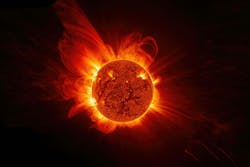NASA looks for a trio of flight chronographs for Space Weather Next L1 Series mission
WASHINGTON - The National Aeronautics and Space Administration announced it is seeking three flight coronagraph instruments for its and the National Oceanic and Atmospheric Administration's (NOAA's) upcoming Space Weather Next L1 series mission. Future observatories will provide NOAA with solar wind data and coronal mass ejection (CME) imagery, which is the National Weather Service’s highest priority for space weather observations.
This competitive procurement is expected to culminate in the award of a cost-plus-fixed-fee (CPFF) completion-type contract featuring technical milestone incentives. The contract's anticipated performance period spans from the award date through the operational handover of the instruments to NOAA, plus fifteen months after the launch of the second mission. This period encompasses successfully launched, post-launch evaluation, calibration, data validation, and on-orbit anomaly investigations. Delivery of the first flight unit is scheduled for December 2027, the second by June 2029, and the third unit is designated as a spare flight unit for the initial two missions.
The selected contractor is responsible for supplying the necessary personnel, materials, facilities, and resources to undertake various tasks under the contract, including the design, development, delivery, storage, and support for spacecraft integration and test, launch, and early mission operations. This encompasses ground-processing algorithm development for the following components:
- Three coronagraph flight model (FM) instruments, each comprising a detector, telescope, associated electronics, and harnesses, designated as Flight Model-1 (FM-1), Flight Model-2 (FM-2), and Flight Model-3 (FM-3).
- One engineering development unit (EDU) instrument, consisting of a detector, telescope, flight mechanical and electrical interfaces, associated electronics, and harnesses.
- Spares and assembled and tested sub-assemblies.
- Four sets of the electrical system test equipment (ESTE).
- Four Coronagraph Emulators.
- One Ground Processing Development System (GPDS).
This competitive procurement will result in the award of a Cost-Plus-Fixed-Fee (CPFF) type completion type contract with technical milestone incentives. The contract will have an anticipated period of performance from contract award through operational handover to NOAA of the instruments plus 15 months, after the launch of the second mission including successfully launched, post-launch evaluation, calibration, data validation, and on-orbit anomaly investigations. The first flight unit shall be delivered by December 2027, the second by June 2029 and the third unit is a spare flight unit for the first two missions.
The anticipated contract award date is October of 2024, with a contract effective date that is yet to be determined. The contract will be performed offsite at the Contractor’s facilities.
All questions regarding this RFP should be submitted in writing, electronically to Jonathan Diggs, Contracting Officer, at [email protected] on or before 25 March 2024. Offerors are encouraged to submit questions as soon as possible for consideration. More information, including documentation, is available at https://sam.gov/opp/8d649331d2c94821ba63421bc70b93d1/view.
